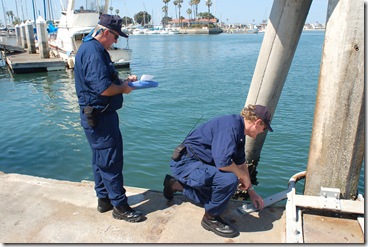U.S. Coast Guard Auxiliary
Public Affairs
PRESS RELEASE
Date: 22 June 2008
Contact: Anthony Turner
Public Affairs Officer
310-908-6950
anthony.turner@auxpa.org
http://www.new.auxpa.org/
TSUNAMI AFTERMATH IN SOUTHERN CALIFORNIA
LOS ANGELES, Calif. On June 22, 2008 from San Diego to as far north as Santa Barbara, members of the U.S. Coast Guard Auxiliary went into alert status as part of a communications exercise following a simulated tsunami that hit along the west coast of California. The purpose of the exercise was to test the communications capabilities of the Coast Guard Auxiliary in the event of a real emergency such as an earthquake or tsunami.
During Hurricane Katrina, Coast Guard Auxiliary communications  facilities played a critical role in effecting rescues throughout the region and in some cases Auxiliary communications were the only communications available. “One of the reasons we have these exercises is to test the coverage area of our VHF repeater network and to test our ability to accurately and quickly get information from an Auxiliarist on a dock with a hand-held radio to an Incident Commander hundreds of miles away", said John Olson, the Chief Communications Officer for the Coast Guard Auxiliary District 11-South which covers all of southern California, parts of Arizona and parts of Nevada. “While today’s exercise was not perfect, we were able to adapt and overcome some problems we encountered, which is part of the learning process.” (Pictured: Coast Guard Auxiliary members check dock following simulated tsunami in southern California - U.S. Coast Guard Auxiliary photo by Anthony Turner, USCGAUX)
facilities played a critical role in effecting rescues throughout the region and in some cases Auxiliary communications were the only communications available. “One of the reasons we have these exercises is to test the coverage area of our VHF repeater network and to test our ability to accurately and quickly get information from an Auxiliarist on a dock with a hand-held radio to an Incident Commander hundreds of miles away", said John Olson, the Chief Communications Officer for the Coast Guard Auxiliary District 11-South which covers all of southern California, parts of Arizona and parts of Nevada. “While today’s exercise was not perfect, we were able to adapt and overcome some problems we encountered, which is part of the learning process.” (Pictured: Coast Guard Auxiliary members check dock following simulated tsunami in southern California - U.S. Coast Guard Auxiliary photo by Anthony Turner, USCGAUX)
The Threat in California
More than a dozen tsunamis with waves three feet high or more have struck California since 1812. Six caused damage. The tsunami generated by the 1964 Alaska earthquake killed a dozen Crescent City residents and caused more than $34 million in damage ($222,783,000.00 in 2007) Three tsunamis flooded Santa Barbara in the 1800’s and a tsunami resulting from a Chilean earthquake damaged a pier in San Diego Harbor in 1960.
Before the Next Tsunami or Tsunami Watch
1. Determine the elevation of your home and how far it is from the coast. Know whether you live in a tsunami danger zone.
2. If you live within a couple of miles of the coast, identify a location to go if a tsunami watch or warning is issued or if you feel an earthquake lasting for 15-20 seconds. The location should be at least two miles inland or 100 feet above sea level.
3. Learn the signs of an approaching tsunami. If the tide rises or recedes rapidly, move immediately inland to higher ground.
4. Ask local emergency officials or your planning department what areas are susceptible to the flooding from a tsunami.
5. Locate refuge areas and learn evacuation routes that are safe.
6. Develop or update your family’s emergency plan.
7. Assemble an emergency supply kit, if you haven’t done so. Include a portable radio. (Consider the purchase of a NOAA weather radio.)
8. Identify a friend or relative living in another state as your family point of contact.
9. Learn first aid.
10. Teach family members how and when to turn off the utilities.
(For more information on tsunamis and emergency preparedness visit www.espfocus.org )
###

